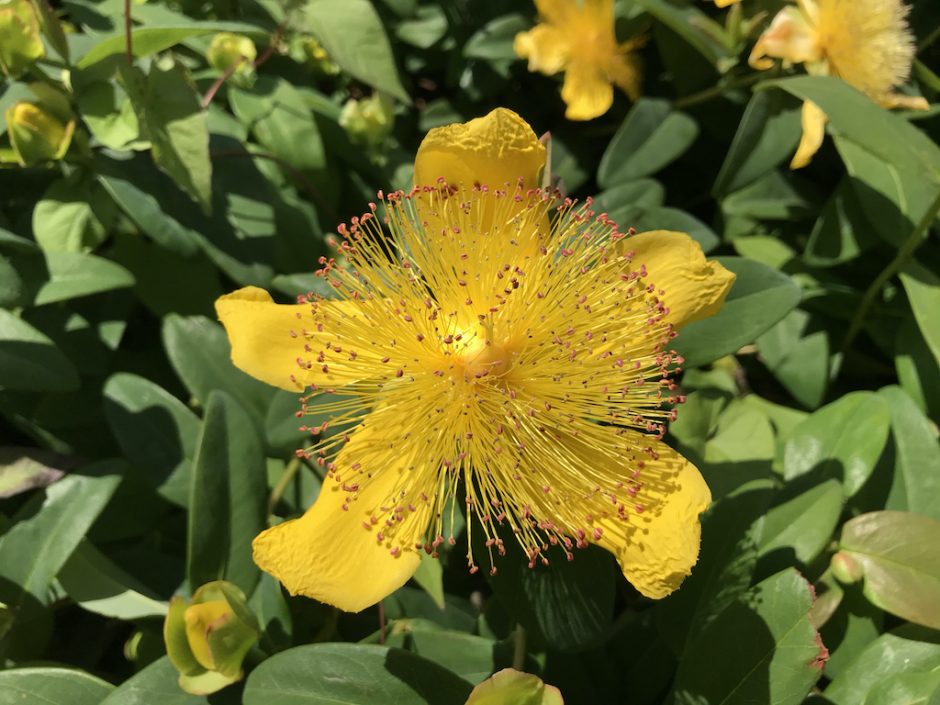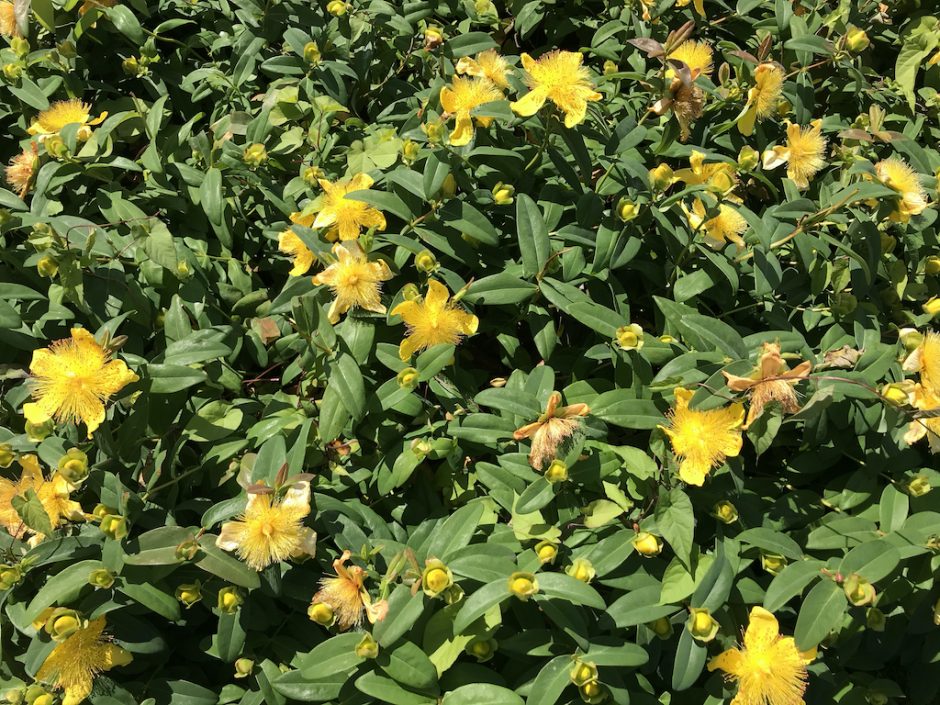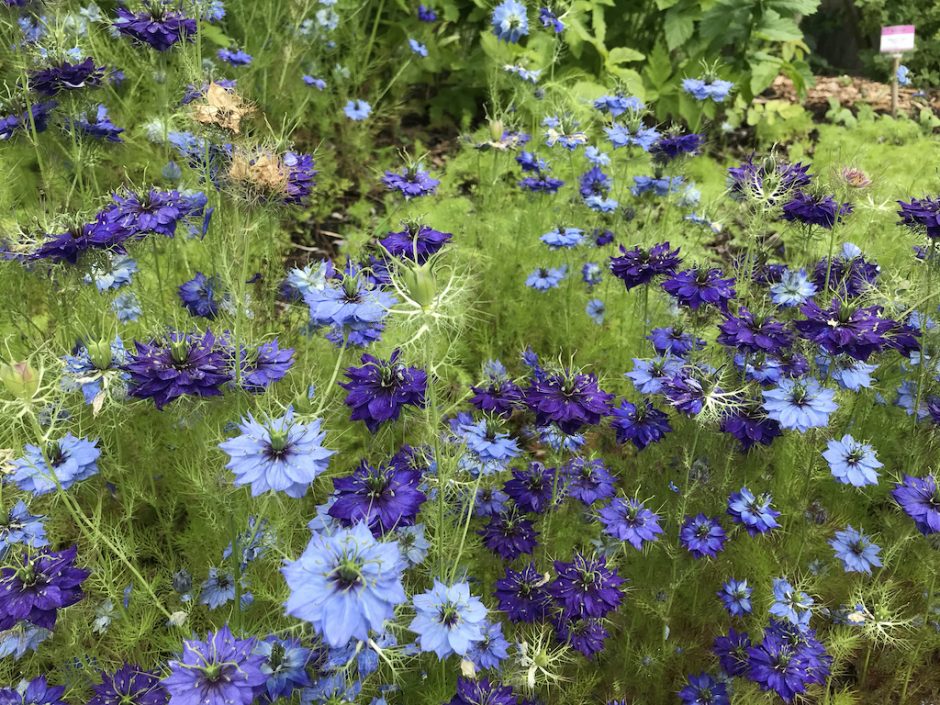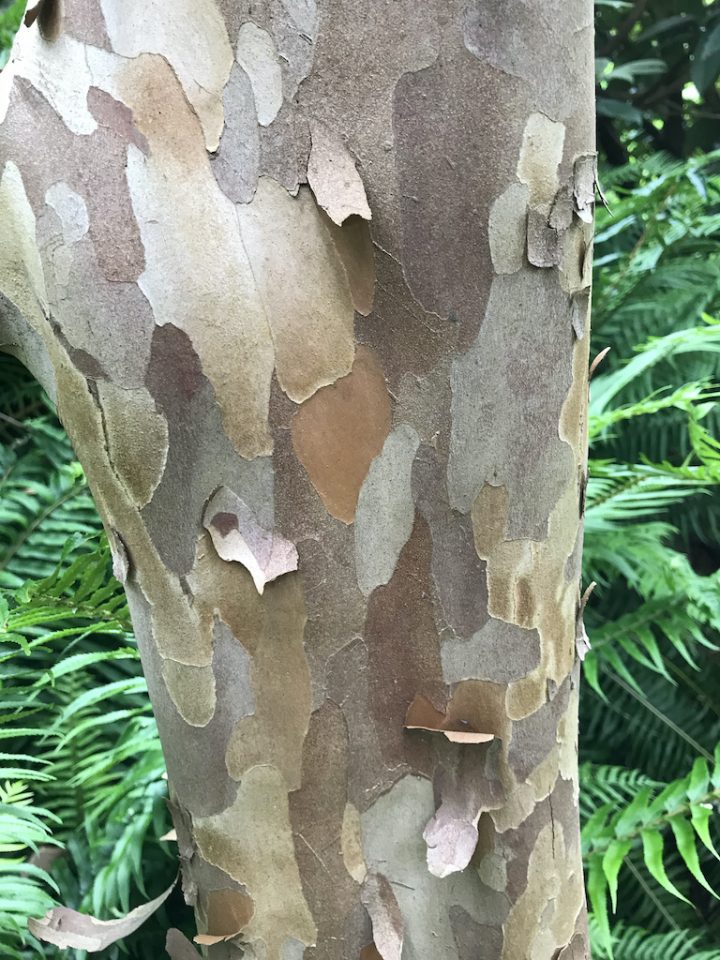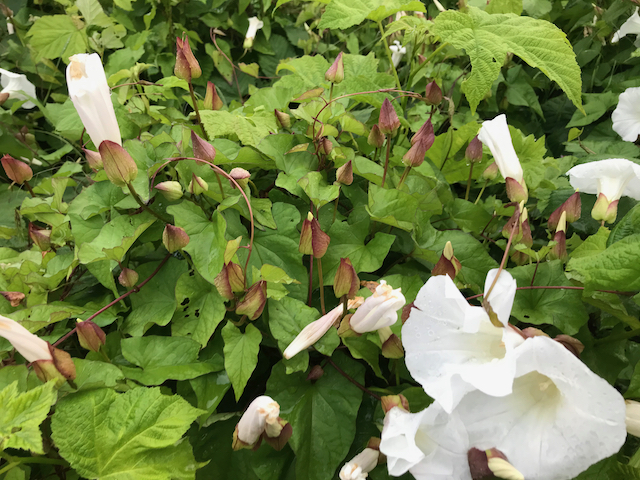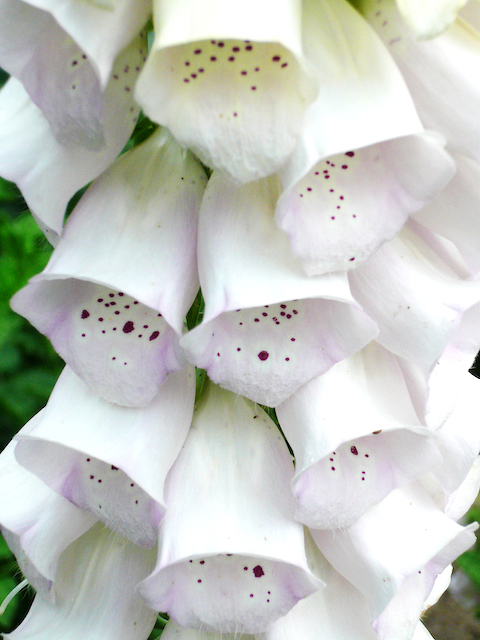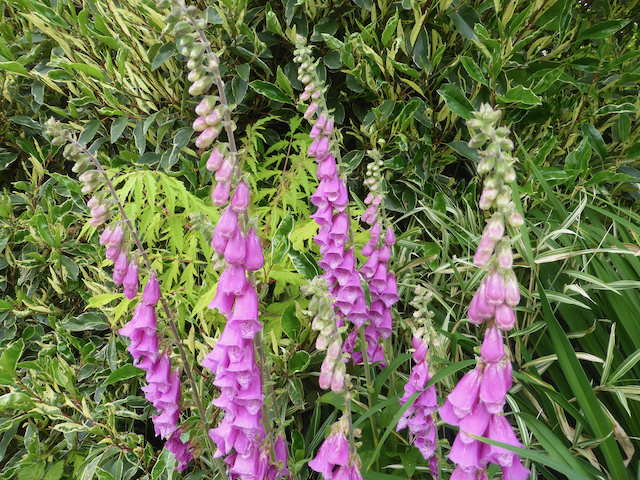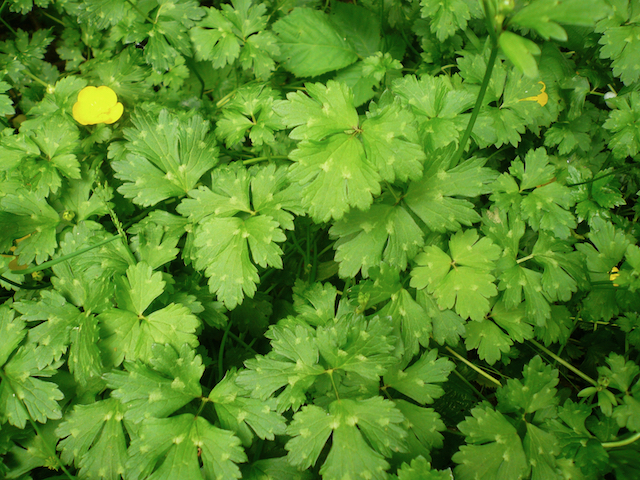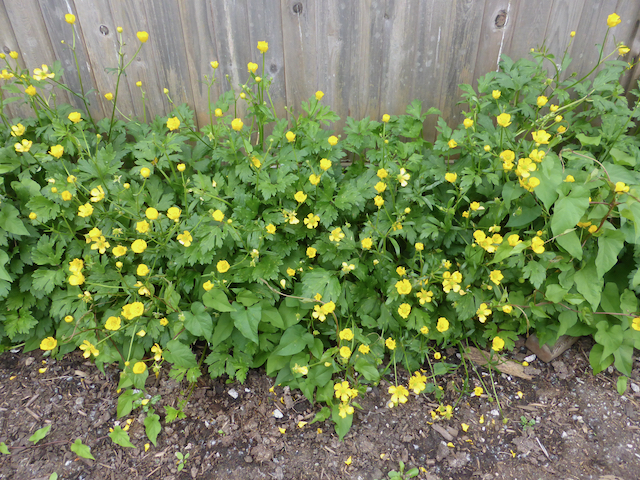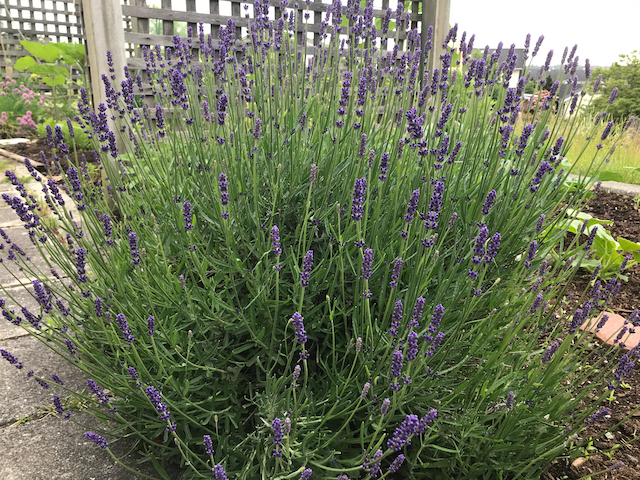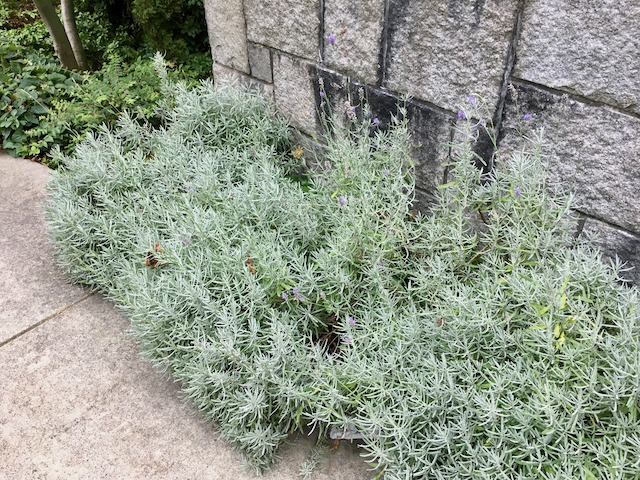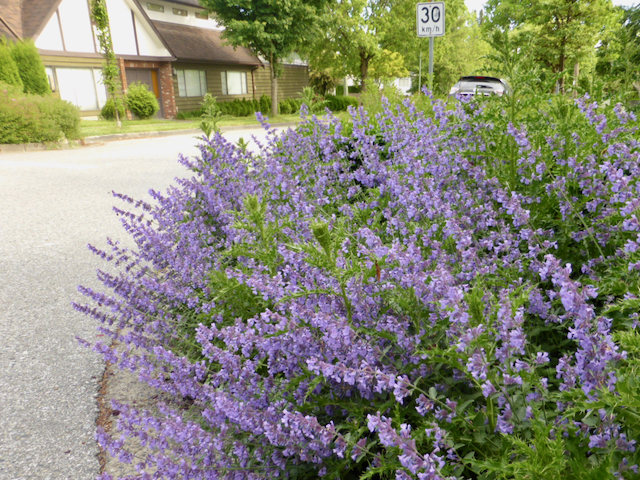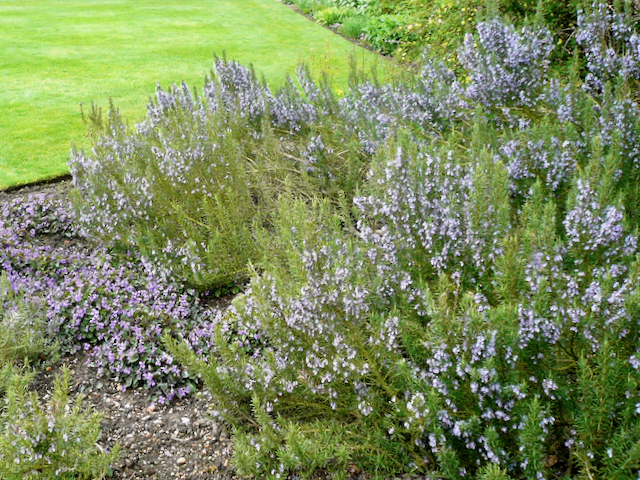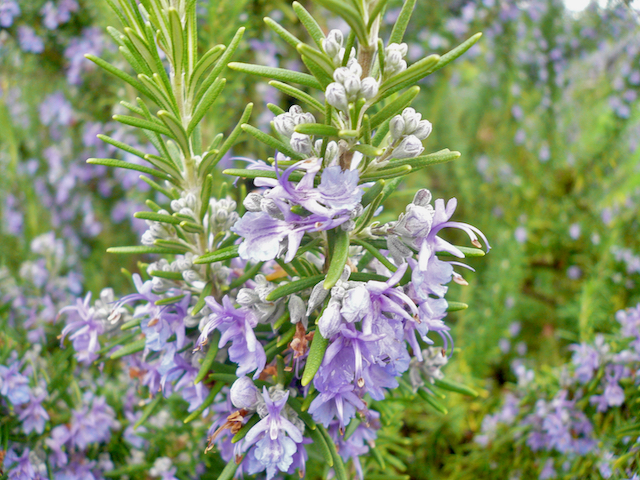June 22-28, 2020
Eschscholzia californica (California poppy)
Eschscholzia californica (California poppy). The escscholzias are primarily annual and short-lived perennial poppies native to the American southwest and Mexico. The genus is named for the Estonian physician and biologist Johann F. G. von Eschscholtz, who collected specimens in California in 1816. California poppy is native from northwestern Mexico north to Washington state. It could be considered almost native to coastal southwestern British Columbia, and it certainly thrives in warm and dry habitats here, but re-seeding populations are usually short-lived around Vancouver, probably on account of our cold and wet winter weather.
Poppies are usually recognized by their brittle, watery stems and four-petaled flowers – this describes the California poppy, but the species is distinctive with its finely dissected blue-green leaves and succulent tap-root, and its extraordinary satin-orange, cup-shaped flowers. The petals have an iridescent quality that is the result of longitudinal microscopic ridges that are prismatic, focusing light deep within the petal and illuminating the orange-yellow carotenoid pigments within.
The flower buds, too, are remarkable. Each is comprised of a pair of fused green sepals. These form a conical cap that encloses the expanding petals. When the petals are large enough, they gradually push off the cap, leaving only a rim of green tissue around the base of the flower. This is easily seen below the developing seed capsules, which are slender and cylindrical, somewhat curved and up to 9 cm long. When ripe, the seeds are released (sometimes explosively) from openings at the base of the capsules. California poppy is usually introduced through wildflower seed mixtures locally.
Hypericum calycinum (St. John’s wort)
Hypericum calycinum (St. John’s wort). The hypericums are readily recognized by their smooth-margined oval leaves borne in opposite pairs along upright, wiry stems, but mostly by their distinctive flowers, which are typically composed of five green sepals, five bright, satiny-yellow petals and numerous, slender, silken stamens surrounding a pear-shaped green ovary. The leaves and stems of most species have a distinctive, if subtle, pleasantly resinous aroma.
Hypericum calycinum is a colony-forming, low evergreen shrub. The handsome, dull green leaves are borne on upright, but reclining, wiry stems that arise from a dense network of shallow rhizomes (horizontal underground stems). Each stem is generally terminated by a solitary flower, which opens between May and July; however, there is usually a progression of the distinctive, 5-cm diameter flowers from the multitudinous stems. If sheared back to the ground every few years (some people use a lawnmower adjusted to the highest setting), this species makes a very tidy, floriferous groundcover. Neglected patches of hypericum (i.e., those that are not periodically cut back) are inevitably infected with hypericum rust, which causes the leaves and stems to become increasingly colonized by small, coalescing orange to rusty brown pustules. The stems of infected plants ultimately defoliate completely, but not before looking particularly gruesome with distortion.
The derivation of the scientific name Hypericum also explains the common name, though the explanation is somewhat tortuous. “The Greek name hypereikon is from hyper, meaning “above” and eikon “a picture.” The flowers of some hypericum species were placed above images to ward off evil at the ancient midsummer festival Walpurgisnacht, which later became the feast of St. John (24 June), when they are in flower” (from Stearn’s Dictionary of Plant Names) – hence St. John’s wort (wort is Old English for “plant”).
Nigella damascena (love-in-a-mist)
Nigella damascena (love-in-a-mist). Like the California poppy, this garden favourite is a hardy annual; that is, it completes its lifecycle within a single year and its seeds are capable of overwintering to start new plants the following spring. Besides self-seeding, N. damascena also tolerates dry, infertile soils and produces flowers over a long period, which is why the species is commonly included in wildflower seed mixtures. Plants have upright stems with finely cut leaves. The degree of leaf dissection increases toward the flowers at the tips of the 20- to 40-cm-tall stems, such that the flowers appear to float in a green mist.
The flowers themselves are somewhat unusual. They are like most other flowers, composed of both petals and sepals; however, the sepals are large and coloured, while the petals are tiny, and even entirely absent in double-flowered individuals. The sepals range in colour from the typical sky blue to white, pink, purple and red.
Developing at the centre of the flowers, sitting above the drying sepals is an inflated seed capsule with twisted horn-like appendages (the style remnants). This is presumably the derivation of the alternate common name, devil-in-the-bush. These balloon-like capsules are much valued in dried flower arranging. Inside the capsule are numerous small black seeds (nigella means “small and black”), and these are used as a condiment in some Middle Eastern cultures, although recent science has identified at least one potentially toxic compound associated with them. Note that the seeds of the related, but less showy N. sativa, which are more commonly used for culinary purposes—they are known as “black caraway”—are generally deemed safe. Native to southern Europe, northern Africa and western Asia, including to Damascus, Syria (damascena means “of Damascus”), N. damascena is now widely naturalized in drier areas around the world.
Oenothera biennis (common evening primrose)
Oenothera biennis (common evening primrose). There’s no getting around that many of our most common flowers are weeds. Not all oenotheras are weedy, but O. biennis is definitely an opportunistic species. Originally native to eastern North America, common evening primrose has escaped cultivation over much of the temperate and subtropical world. Besides having attractive flowers, all parts of the plant are edible (at least at some stage of development) and the species is the source of the much-ballyhooed evening primrose oil. Evening primrose oil is reputed to be effective for a range of medical symptoms, although clinical evidence does not appear to back up many of the claims, other than the finding of a moderate improvement in patients suffering from eczema.
Like the similar-sized Digitalis purpurea, O. biennis is a biennial, starting out as a lush, stemless rosette of large leaves, only flowering in the second year, after a period of cold winter dormancy. The leaves are long and narrow, up to 30 cm in length, shiny, dark green with a light green midrib. Flowering stems are leafy, up to 1 to 2 m tall, producing attractive, yellow, four-petaled, 3- to 5-cm wide, funnel-shaped flowers that radiate all around the stems.
The flowers open around sunset (hence, evening primrose) and are pollinated by moths. They remain open until the morning of the following day, whereupon they often become pale orange as they wilt. The seeds, which are produced in narrow, green seed capsules 3 to 4 cm long (they look like miniature cucumbers), can apparently be used as a substitute for poppy seeds in baking. The taste of the seeds (raw or roasted), leaves (boiled twice), flower buds (raw or cooked), flowers (in salads), and seed capsules (roasted) are apparently an “acquired taste” for many. The name Oenothera is pronounced “ee-no-theer-ah.”
Stewartia pseudocamellia (Japanese stewartia)
Stewartia pseudocamellia (Japanese stewartia). Hailing from Japan and Korea, this species is the most commonly cultivated of all stewartias and arguably, the most ornamental. It is often given as an example of a tree that has value in all four seasons. It has a sculptural branching, superlative flaking bark, showy summer flowers, attractive woody fruits, and clean foliage (but note that nearly all other Stewartia species also share most of these features).
Japanese stewartia is most easily recognized by its papery, flaking bark, which exposes irregular patches of grey, tan, brown and cream as it exfoliates. No other tree that is hardy in Vancouver comes close to imitating the look of its stems, and few exfoliating trees look as good at such a young age. The oval-pointed, dark green leathery leaves are finely toothed, and the margins usually attractively reddened when exposed to the sun. The leaves emerge from long, strongly pointed silky buds in late April or early May, and take on burnt orange, red or purple tints before falling. Flowers appear in late June or July from copiously produced globose buds. The flowers are 5 to 6 cm across when fully opened, the boss of yellow-anthered stamens standing at the centre of the pure white, crepe-like rumpled petals resting against the leaves. They closely resemble the flowers of camellia, hence the specific epithet (pseudocamellia = “false camellia”). The leaves are an attractive foil for the flowers, but also prevent the flowers from being seen from below when borne on horizontal branches.
Trees are usually shrubby in youth but can grow to about 10 m tall. Stewartia is named for John Stewart, the third Earl of Bute and a promotor of botanical science in the 18th century.
June 15-21, 2020
Calystegia sepium (bindweed, morning glory)
Calystegia sepium (bindweed, morning glory). Many people are familiar with this invasive herbaceous perennial climber. Stems are up to 3 or 4 m in length and bear arrowhead-shaped leaves. The stems arise from brittle, whitish rhizomes (a rhizome is a modified, mostly horizontal underground stem). Bindweed stems twine in a counterclockwise direction. Charles Darwin (who was fond of measuring things) noted that they make two full revolutions around an object in one hour and forty-two minutes. The large, pure white to pinkish trumpet-like flowers are about 7 cm across. The flowers are lovely to us and attractive to bees and other insect pollinators, but only open for a single day. Twining and climbing around any object in its path and flowering heavily all summer long, bindweed can also produce copious seed, but only where multiple seedlings are close together. Without cross pollination (which is often the case locally) no seed will be produced.
Seeds and rhizome fragments are easily moved around in incompletely composted soil, and the soil from backyard compost boxes is a common source of new growth. A piece of rhizome less than 5 mm long can produce a new plant, and each plant can have a network of rhizomes that extend over scores of square metres. Rhizome growth has apparently been clocked at an impressive 25 cm per day. Plants often spread un-noticed down shady laneways, in lawns and under dense shrubs. Wherever there is sunshine and something to climb—a grass-stem, fence post, hedge (sepium means “of the hedges”) or tree, bindweed will make a mad dash for the sky. Bindweed is now so ubiquitous in neglected gardens and waste places around Vancouver that it easily finds its way into well-tended gardens that border on these places, making gardeners crazy wherever it appears. The species is differentiated into a number of subspecies (geographical variants). While there are North American subspecies, the plant that plagues Vancouver gardens is recognized as the European subspecies.
Digitalis purpurea (foxglove)
Digitalis purpurea (foxglove). The common foxglove is a European plant widely naturalized around the temperate world. The plant is renowned for a couple of reasons. Children love the flowers, which are like bulging, silky pockets, perfect for imagining on the paws of foxes. The flowers are not adapted to vulpine footwear (sadly), but to bumblebee pollination. They are typically pale purple with darker spots, or sometimes pure white (with or without spots), 3 to 4.5 cm long and wide, borne often on one side of a 1- to 1.5-m-tall stalk.
The foxglove’s second claim to fame is in its long history in folk medicine, and now, modern medicine. Nowadays, physicians use digitalis and its derivative drugs to treat congestive heart failure and hypertensive heart disease. However, foxglove is highly toxic, and has caused many accidental deaths after ingestion. Digitalis should never be used without a physician’s supervision, as the threshold between a therapeutic dose and a fatal one is extremely small.
Digitalis purpurea has a biennial life-cycle. Biennial plants typically grow a stemless rosette of leaves in the first year from seed, then, after a winter dormancy period, throw up a flower stalk. This often leads to some confusion, as the basal rosettes of foxgloves, although large, are often overlooked in the first year, and the flower stalks “appear out of nowhere” in the second year. As long as pollinators visit the open flowers, a typical biennial like foxglove will set seed and then die. The leaves of D. purpurea are similar to the common (often weedy) perennial garden herb, comfrey (Symphytum officinale) for which it is sometimes mistaken. However, in comfrey there are normally multiple stems with many narrow leaves, and the leaves and stems are endowed with bristly hairs. The leaves of foxglove are broader and have soft hairs, and the flowers are larger and borne on much taller stems. To be clear, both species are toxic. Ingesting foxglove can lead to heart failure; ingesting comfrey, to liver failure. Foxgloves spread by copious seed and sometimes, root fragments.
Kniphofia (poker plant, torch lily)
Kniphofia (poker plant, torch lily). One of the most visually arresting groups of herbaceous perennials grown in Vancouver is the southern African genus Kniphofia. They are easily recognized, as they generally look like nothing else in our gardens. Club-like flowering stems arise from handsome rosettes of tough, strappy leaves, and produce tight clusters of yellow-to-orange tubular flowers. In most species and hybrids, the open flowers lie below the younger, often darker coloured flower buds. The newest flower buds develop at the apex of the stalk as the flowers open progressively toward the tip. This results in a two-toned, yellow-and-orange effect and is probably a signal to pollinators directing them to the nectar-filled flowers. This colour is likely where the plant gets its common names (the fireplace poker, if left in the coals glows orange at its tip).
In habitat, pollination of these flowers is carried out by sunbirds, a family of small, often iridescently-coloured birds with curved bills. Because sunbirds cannot properly hover (only the so-called New World birds—such as hummingbirds—can perform this feat), they must first alight and grasp the stalk to drink the nectar produced at the base of receptive flowers. For this reason, the stalk must be relatively stout. Note that flowers adapted to hummingbird pollination are often borne on supple, wiry stalks and have a horizontal posture, so that the hummingbird can sip nectar while in flight.
Kniphofias have become very popular in the last few years, especially smaller-growing species and hybrids with pastel-coloured flowers, but the toughest, longest-lived plants are the big, brash, yellow and orange flowered ones, such as K. uvaria and its hybrids. Most English-speaking people pronounce the name “niff-oaf-ee-ah”, but the genus is named for the German physician and botanist, Johann Hieronymus Kniphof (1704-1763) whose name is pronounced Knip-hoff (i.e., with the “k” sounded).
Ranunculus repens (buttercup, creeping buttercup)
Ranunculus repens (buttercup, creeping buttercup) is an aggressive, smothering weed of mostly wet places, with extensive stolons (modified horizontal ground-level stems) and deeply penetrating, fleshy roots. New plants arise from rooted nodes on stolons, root fragments or seeds. The species is originally native to Asia, Europe and northern Africa, but is now widely naturalized and an invasive species in many parts of the world. Although British Columbia homes around three dozen Ranunculus species, creeping buttercup is so common locally (and elsewhere), that it is usually called simply “buttercup.” The species is common in moist (especially winter-flooded) lawns and compacted and disturbed soils, but grows best in deep, moist, fertile soil. The species readily grows along the ground (repens means “creeping”), producing flowers on compact stems (this is a common behaviour in lawns, where repeated mowing curtails upright growth), but given half a chance, upright stems quickly stretch out and reach upwards to 50 or 60 cm in height.
Like most plants in the buttercup family, the leaves of creeping buttercup are compound (i.e., composed of separate leaflets). The leaf stalks are long or short, depending on whether plants are prostrate (then short) or more upright (then up to 40 cm long). There are typically three more or less sparsely hairy leaflets, each one deeply lobed with a small pale spot at the base of each sinus (the gap between lobes). Leaves on the flowering stems are smaller. Individual flowers are usually five-petaled, about 1 cm across and cup shaped when fully open. The petals are an iridescent golden yellow and surround a boss of between thirty and eighty tiny stamens.
Researchers have discovered that the shape of the open flower and reflectivity of the petals contributes to heating of the flower and its attraction to insect pollinators. Plants display an almost continuous supply of these attractive yellow flowers, and this would be seen as desirable in the garden, except that the plants are so aggressive that they easily out-compete and smother weaker plants. Left alone, the garden soon becomes mostly buttercups.
Spiraea japonica (Japanese spirea)
Spiraea japonica (Japanese spirea). Spireas are exceptionally common deciduous garden shrubs and this variable species is one of the most common spireas in local gardens. A native of China, Japan and Korea, S. japonica grows on moist forested slopes, in gulleys, valley bottoms, bogs, wetland margins and in alpine steppe. Low elevation plants are normally robust and tall, while those from higher elevations or more northerly locations are shorter with smaller leaves. Plants grow 30 cm to about 1.25 m tall with lower branches reclining and often layering (rooting in place) and thus, creating a spread wider than plants are tall. Shoots are slender and initially vigorously upright, but quickly develop wiry secondary and tertiary branching. This tends to dissipate the vertical energy of the shoots, and the plants remain compact and bushy, their height building up only slowly.
The dark green leaves are mostly oval or longer, and pointed, 1.5 to 8 cm long, and prominently toothed along the margins. Individual flowers are pink, mauve or rarely white, only 4 to 7 mm across. They are freely produced in flattened, compact clusters in early summer. Spiraea japonica is a “garden escape” in eastern North America, but it is not invasive in the Vancouver area. The species is mostly known by its numerous cultivars and garden hybrids available in commerce. These are promoted on the basis of their colourful foliage (leaves may be copper-coloured, wine-red-edged, chartreuse, or golden-variegated, etc.), and also their considerable variation in size. There is even a cultivar, ‘Shirobana’, that displays both pink and white flowers in the same flower clusters.
June 8-14, 2020
Hydrangea petiolaris (climbing hydrangea)
Hydrangea petiolaris (climbing hydrangea). This deciduous climber, native to Japan, can grow to be more than 25 m tall. The stems initially lie flat against any porous vertical surface (tree bark, masonry, wood fencing, etc.) so that the specialized aerial roots can attach themselves. When plants are mature enough to flower, they produce short lateral branches that extend horizontally outward. The leaves of H. petiolaris are 5 to 10 cm long, usually broadly oval with an abruptly pointed tip, a more or less heart-shaped base, and a finely serrated margin. The leaves are borne on a 2- to 8-cm-long petiole (leaf stalk). The long petiole, which gives the species its name, is a good indicator of the climber’s shade-tolerance. In general, long petioles in plants allow leaves to efficiently splay out radially, to reduce self-shading and take best advantage of limited light for photosynthesis.
Flattened heads of creamy-white fertile flowers are surrounded by a few conspicuous pure white, four-sepaled, sterile, “flag” flowers (note that the petals are much smaller and the sepals are expanded in the flag flowers). These flattened clusters are produced at the stem tips in early summer. Open flowers smell fruity and sweet (a little like Juicy Fruit® gum). Mature stems have attractive brown papery bark that exfoliates in irregular curls and shreds. While this species is generally grown as a climber, it can be easily trained to form a handsome stand-alone shrub by planting away from climbable surfaces and regularly removing straggling stems.
Lavandula angustifolia (English lavender, spike lavender)
Lavandula angustifolia (English lavender, spike lavender). Species in the mint family are generally recognized by their strongly and often pleasantly aromatic tissues, but also by their square stems, opposite leaves and five-lobed flowers with a persistent calyx (the calyx is the collective term for the sepals). A close (very close) look at the flower-bearing stems shows that the flowers are actually produced in tiny, paired clusters along the stem. English lavender is the most commonly cultivated lavender in temperate gardens. It is also the lavender cultivated commercially for its oils in perfumery. The species is native to southern Europe from Spain to Italy, and, despite the common name, not native in England.
Plants usually have multiple ascending stems, 30 to 50 cm tall from a branched, more or less reclining woody base. Erect flower stalks arise at the tips of the current season’s growth, extending above the leafy shoots for a further 10 to 20 cm. The leaves of English lavender are grey-felty and more or less linear (angust = narrow + folia = leaf). The youngest leaves have distinctly recurved (rolled over) margins. The flowers of English lavender are mauve to purple (rarely pink or white and never truly blue). The L. angustifolia flower stalk can be 10 to 50 cm long, with the part of the spike populated by flowers generally no more than 5 to 10 cm long and about 1.5 cm in diameter.
Nepeta x faassenii (Faassen’s catmint)
Nepeta x faassenii (Faassen’s catmint). Not to be confused with catnip, which is a related species (N. cataria), catmints are robust herbaceous perennial plants noted for their grey-green leaves and June-borne masses of lavender- to violet-blue flowers. There are some 250 catmint species (only N. cataria attracts cats), the majority of cultivated species displaying sprawling stems and white or blue flowers. Like lavender and other mints, the catmints have square stems, oppositely arranged, toothed leaves and two-lipped flowers. Faassen’s catmint is a hybrid and has extra vigour, as hybrid plants often do. Plants are sterile, as well, which means they do not put any energy into producing seed. This translates into a longer-lasting flowers, which is why N. x faassenii is as popular as it is.
The plant gets its name from the Dutch nurseryman J.H. Faassen, in whose nursery the hybrid first arose. There are now several cultivars of N. x faassenii available, the most popular in Vancouver including two upright-growing plants: ‘Dropmore’ with larger leaves and flowers, and stems to 60 cm tall; and the even larger ‘Six Hills Giant’, which grows to 90 cm tall and has sizeable flower stems with dark violet-blue flowers. Note that Dropmore does not describe the shape of the plant, but the Canadian Agricultural Research Station in Dropmore, Manitoba. If the gardener takes the time to cut the stems of N. x faassenii back after the flowers have faded, a second flowering will usually take place.
Rubus bifrons (Himalayan blackberry)
Rubus bifrons (Himalayan blackberry). Himalayan blackberry is a spectacularly aggressive, thicket-forming, deciduous to evergreen bramble familiar to anybody who has ever tried to brush by one or has eaten its delicious, succulent blackberries. Rubus bifrons is common in especially moist, waste places around Vancouver. Plants spread by vigorous roots, rooted stem tips and bird-deposited seeds, and are frequent in open spaces where birds congregate. Thickets are often extensive and impenetrable. The arching, woody stems are 5 to 15 mm in diameter, and well-armed with viciously sharp, hooked prickles. Plants usually grow to 5 m in height, but the unusually long-lived stems can extend to more than 12 m long and will climb into the branches of trees. Leaves are palmately compound, the three to five oval leaflets, 2 to 15 cm long. The middle leaflet is largest, with leaflet size diminishing symmetrically toward the outside. The underside of the leaf is waxy-white and there are sizeable prickles on the petiole and the main veins. Note that these sharp protuberances are called prickles, rather than thorns or spines. Each of these armaments has a specific technical meaning: thorns are modified (often shortened) branches; spines are modified from leaves or parts of leaves, and prickles are mere outgrowths of the stem’s epidermis (they can be broken off with no damage to the stem).
As noted, Himalayan blackberry is valued for its delicious fruits, which can be large (up to 2.5 cm long) and are usually plentiful in early summer. The species provides shelter for all kinds of wildlife (including urban animal pest species) and affords effective security along property boundaries. It is often assumed that R. bifrons is the blackberry of commerce, but the commercial blackberry in North America is a complex hybrid whose parents include our native trailing blackberry (R. ursinus), the European red raspberry (R. idaeus) and Himalayan blackberry.
The name bifrons means two leaves, which might seem to make little sense (one might search in vain for paired leaves), except in the sense that the upper and lower leaf surfaces are so different as to appear to come from different leaves. This is reflected in the German common name for this species, zweifarbige brombeere, which translates as two-coloured bramble. Scientifically, R. bifrons bears the burden of several historical name changes—it has been known at various times as R. procerus, R. discolor, and for the last few decades (until R. bifrons came to the fore), R. armeniacus. These changes are not only confusing, but they undermine the supposed reliability of scientific names. Awkwardly, the common name is a problem, too. The common name Himalayan blackberry evidently has its origin with the famous American fruit breeder, Luther Burbank, who gave a plant he imported the cultivar name ‘Himalayan Giant’. We assume that Burbank considered the plant a particularly robust selection of a species that originated in the Himalayas. However, R. bifrons is actually native to Europe.
Salvia rosmarinus (common rosemary)
Salvia rosmarinus (common rosemary). It will come as a shock to many gardeners that the familiar and beloved culinary rosemary is no longer listed under Rosmarinus officinalis (the name it has had since 1753) but is now considered a species in the genus Salvia. Recent analyses comparing the DNA of rosemary with salvias and a number of other closely related plants have shown convincingly that the rosemarys and salvias are too closely related to be separated. The common rosemary is an evergreen shrub native to the Mediterranean region (one can usually find the healthiest plants growing in hot, sunny locations) and it is aromatic in all of its parts.
Rosemary leaves are more or less linear, dark green above and grey white beneath, and the margins are strongly recurved. The flowers are small, usually pale blue, and the clusters appear toward the tips of the branches and crowded amongst the densely tufted foliage. The individual flower presents a broad, concave lower lip, and two lateral petals that curve inward. Together, the three petals create a bowl-like target for pollinators, which are usually bees. The uppermost petal is often split into two narrow lobes that spread apart to accommodate both the style (the narrow extension of the ovary that carries the pollen-receptive stigma at its tip) and a pair of stamens (the structures that bear the pollen-containing anthers at their tips) that extend upward from the centre of the flower then arch over.
When ripe, the anthers release their pollen as they are brushed by visiting insects landing on the lower lip. At a different time, an insect may deposit pollen from another flower onto a receptive stigma. Cultivated rosemarys vary from strongly upright to reclining shrubs, and flower colour can range from white to pink, purple and bright blue. Flowers are marked with nectar guides: usually darker purple spots and white lines.
June 1-7, 2020
Cotoneaster dammeri (bearberry cotoneaster)
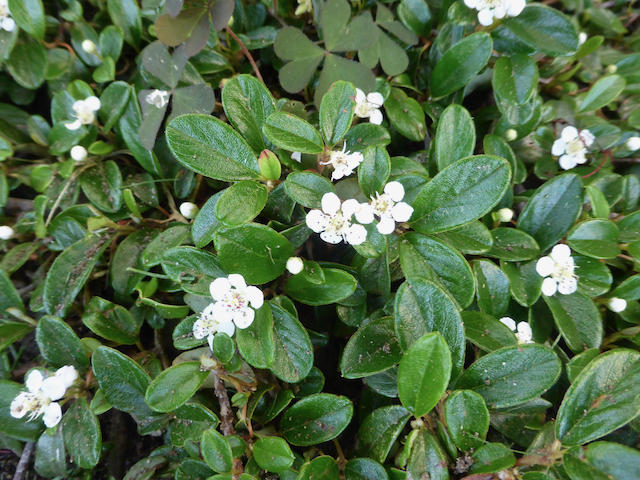
Cotoneaster dammeri

Cotoneaster dammeri

Cotoneaster dammeri ‘Lofast’
Cotoneaster dammeri (bearberry cotoneaster). This variable species from middle-to-high elevations in western China has small evergreen leaves with recurved (rolled-over) margins, and flexible, reclining stems. Cotoneasters typically have handsome leaves and attractive, mostly red or sometimes black fruits. The flowers are often small and not worth remarking on from an ornamental standpoint, but they are nectar-rich and are an important early summer nectar source for bumblebees and other native bees, as well as honeybees. The fruits are universally known as berries, though they are technically pomes, and more akin to the fruits of apples and pears than to true berries.
In C. dammeri, tiny white flowers are followed by small clusters of 6- to 7-mm-diameter orange-red pomes that are held tightly to the stems. The species is best known in local commerce by two very different-looking selections: ‘Major’ has long-stalked, flattened, nearly round leaves about 10 mm long, and completely prostrate, rooting stems that can grow to 2 m or more in length. Locally, it is sold simply as C. dammeri. It looks and performs best growing down a wall or steep, rocky slope. The other common selection of Cotoneaster dammeri is the cultivar ‘Lofast’ (usually listed as ‘Lowfast’). This was once exceptionally popular in Vancouver and the Pacific Northwest for its astoundingly rapid, carpeting behaviour. ‘Lofast’ has small oval leaves and an often conspicuously impressed midrib. The strongly recurved margins usually make the leaves appear narrower than they are. They are borne sparingly on arching stems that root whenever they touch the ground. The stems then form new sets of low, looping branches. For an evergreen, it can be particularly “stemmy” and naked looking, but a well-maintained, regularly sheared planting can look pretty good, and unpruned plants can be attractive while flowing down a semi-shaded slope or hanging down a wall.
Iris (bearded hybrid iris)
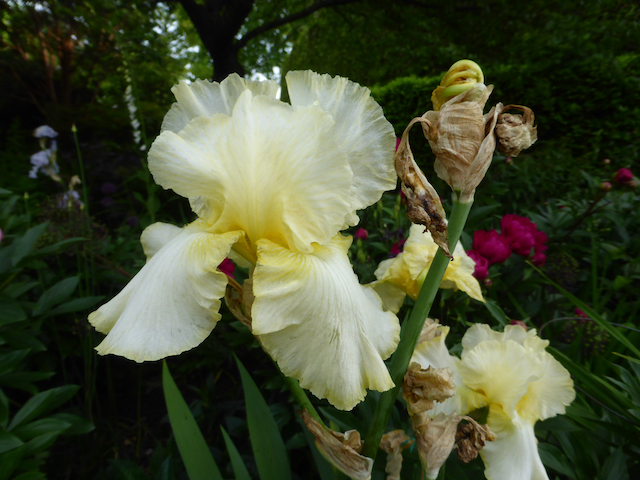
Bearded hybrid iris
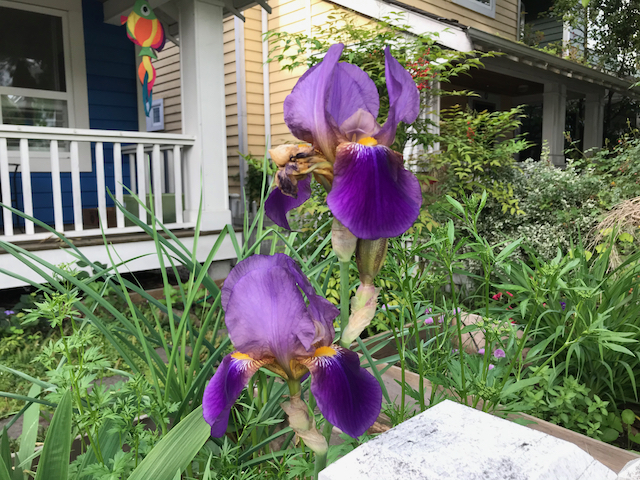
Bearded hybrid iris
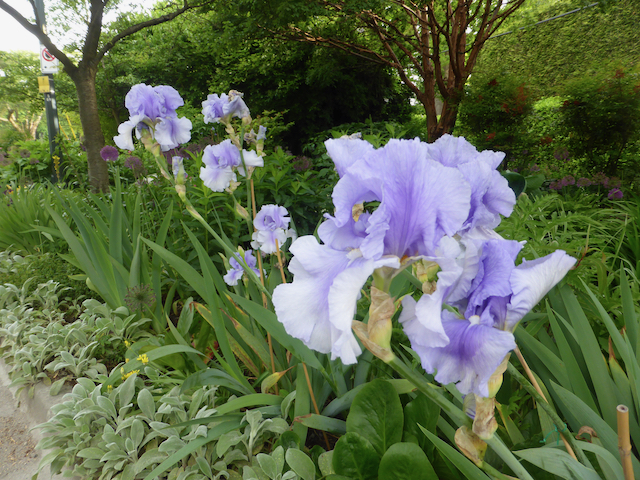
Bearded hybrid iris
Iris (bearded hybrid iris). The genus Iris is named for the Greek Goddess Iris, messenger of Juno, the Goddess of marriage. Iris is said to have traversed the space between heaven and earth over a bridge made by the rainbow, carrying water from the sea to replenish the clouds. Wherever on earth she set down, her footprints bore flowers in a rainbow of colours. Nice job if you can get it. Although there are several categories of Iris (e.g., Junos, Siberians, Louisianas, Reticulatas, etc.) and nearly three hundred species from which to choose, the majority of people are most familiar with the bearded hybrids of commerce (the most popular of these, the “tall bearded” irises). This is not surprising, as bearded hybrids are easily grown in gardens, have very large, showy, fragrant flowers, and are available in an enormous variety of colours. Sometimes mistakenly called German iris (Iris x germanica), which is a different plant, the bearded irises are derived from hybrids made from a small number of European species.
Bearded irises grow from a rhizome (a modified, thickened, horizontal stem). The rhizome is an overwintering structure, visible at the soil surface and from which leaf and flower buds arise. In some irises the rhizomes are smaller and buried in the soil, and in other irises there are no rhizomes at all, and the plants emerge from underground bulbs. In all irises, leaves are mostly sword-shaped and produced fan-like in one plane (this arrangement is known as “equitant” and is common to nearly all plants in the iris family). The flower stalks of bearded irises are produced from the centre of the largest of these fans, and multiple flower buds are borne on each stalk, opening in succession over a few weeks in late May and June.
The flowers, although larger and more elaborated than other irises, conform to the basic iris flower plan. That is, flower parts are in threes. There are six segments (individual petal-like structures comprising the floral envelope): three erect standards (upright segments) and three reflexed falls (pendulous segments). Bearded irises have a “beard” of hairs that adorn usually the widest part of the falls. Between the standards and falls (but often obscured by the standards), is a set of three small, arching style branches, which form tunnel-like covers for the pollen-bearing anthers. In the flowers of most kinds of plants, the style is a slender structure arising out of the ovary and tipped by a stigmatic (pollen-receptive) surface. When pollen is deposited on the stigma, a pollen grows a tube down the style to the ovary. In this way, the ovules can be fertilized and grow into seeds. In Iris, the style branch is a flattened, curving structure with a stigmatic crest at the tip, and the ovary is deep within the flower. Pollinating insects—bees primarily) have to traverse the narrow tunnel entrance to gain access to nectar at the top of the ovary, and in doing so, either dust themselves with pollen or deposit collected pollen on the stigmatic surface as they brush by.
Paeonia lactiflora (common peony)
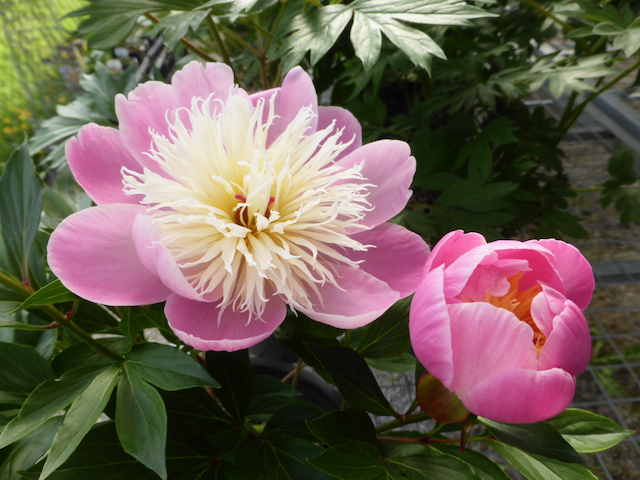
Paeonia lactiflora ‘Bowl of Beauty’
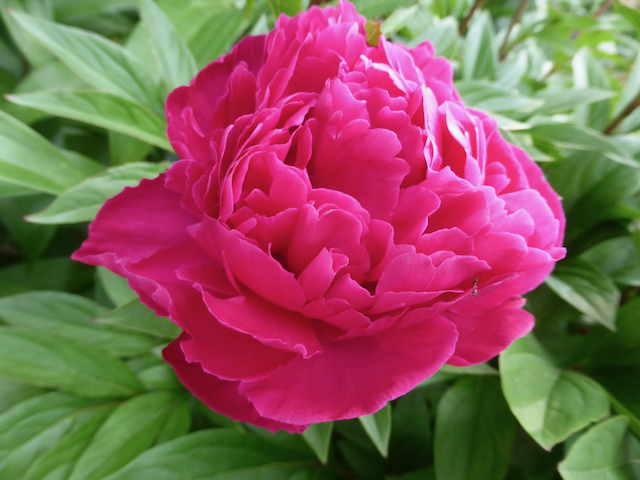
Paeonia lactiflora

Paeonia lactiflora

Paeonia lactiflora
Paeonia lactiflora (common peony, Chinese peony). There are two kinds of peonies: shrubby peonies that produce a woody scaffold of branches—the so-called tree peonies—and the herbaceous kinds, which represent the vast majority of Paeonia species. They are native primarily to drier areas of the Northern Hemisphere, especially in Europe and Asia. Both sorts produce magnificent globe- to bowl-shaped flowers, often composed of numerous huge, overlapping petals. The flowers are produced toward the tips of the current season’s growth, usually in May or June.
The herbaceous peonies include the classic, common peony, P. lactiflora, which is named for the white petals of some selections of the species (lacti = milky + flora = flower). Paeonia lactiflora is native to central and eastern Asia and has been cultivated across China for hundreds of years, both for the beauty of its flowers and for its sublime fragrance, as well. Botanically, the P. lactiflora flower is composed (from the outside of the flower) four or five leaf-like bracts that intergrade with a set of three or four variously sized and shaped sepals (which previously enclosed the unopened flower bud); four to thirteen large rounded, brightly coloured petals; and up to two hundred and thirty stamens with bright yellow, pollen-bearing anthers, all surrounding two to five peaked ovaries that are fused together at their bases. All of these features are easily seen in the open flowers of wild-type peonies, but not so much with many of the cultivated ones.
Peonies with huge, multi-petaled and highly ornamented flowers are much more common in gardens, and they are popular cut-flowers, as well. The extra petals in these flowers are derived from the stamens. Perhaps surprising to most people, stamens and petals are very similar structures anatomically, and it is common for the stamens of especially cultivated peony flowers to mutate into petals. Commonly-grown peony types include “singles” (with a normal number of petals), “semi-doubles” and “doubles.” Doubles and semi-doubles have more than the normal complement of petals. There are fewer petals and stamens visible at the centre of a semi-double flower, while in the double, the whole centre of the flower is completely crowded with petals. Anemone-type flowers are doubles with narrow petals (these narrow petaloids are halfway between stamens and petals). The so-called “Japanese types” are doubles or semi-doubles where the inner petals are a contrasting colour.
Salvia officinalis (culinary sage)

Salvia officinalis
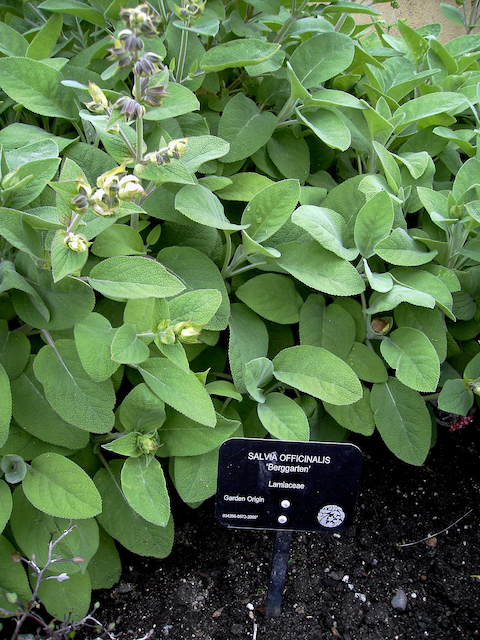
Salvia officinalis ‘Berggarten’
Salvia officinalis (culinary sage) is an evergreen subshrub native to southeastern Europe, and familiar to most gardeners both for the powerful, pleasing aroma of its leaves and its use in Mediterranean cooking and folk medicine. Culinary sage has significant ornamental qualities, as well. Like most other Mediterranean subshrubs, S. officinalis requires and open sunny position in exceptionally well-drained soil (a subshrub has a woody base and more or less herbaceous shoots). Plants are tolerant of infertile soil, and drought once they are established, and can be pruned repeatedly with little negative effect, other than the loss of flower buds (the species is adapted to being browsed by sheep and goats). Excessive soil moisture, high humidity, especially when coupled with summer heat, sustained temperatures below about minus 8 °C and cold, desiccating winds are serious problems for the species. In Vancouver, plants can look pretty unappealing during and after a typical winter of cold temperatures with unrelenting moisture, but they will eventually recover if well-sited. This year, presumably because of our dry spring, culinary sages are looking spectacular.
Young tissues of Salvia officinalis are greyish green and initially minutely hairy, the stems becoming brown barked and woody with age. Plants grow into broad, hummocky bushes to a metre tall or less, with a network of sinuous, more or less reclining stems that spread on or near the ground. The leaves are variable in size and shape—most commonly they are oblong and 1 to 8 cm long, with a finely corrugated surface. The showy blue to mauve-purple flowers are produced in few- to many-flowered clusters in 4- to 10-cm-long spikes at the tips of the branches in June. The individual flowers are strongly two lipped, the upper lip with a small projecting hood and the lower lip about 1 cm by 1 cm, comprised of two broad lobes. The bell-shaped calyx (the calyx is the collective term for the sepals) is about 1 cm long, maroon to bright violet-purple and sharply toothed. During fruit development, the calyx dulls to grey-green and expands to about 1.5 cm to accommodate the four enlarging seeds. In the wild, the spiny seed-containing calyx break offs and easily become entangled in the hair of a passing grazing animal. The seeds are then eventually dispersed as the calyx dries up and cracks open.
Styrax japonicus (common snowbell, snowbell, styrax)
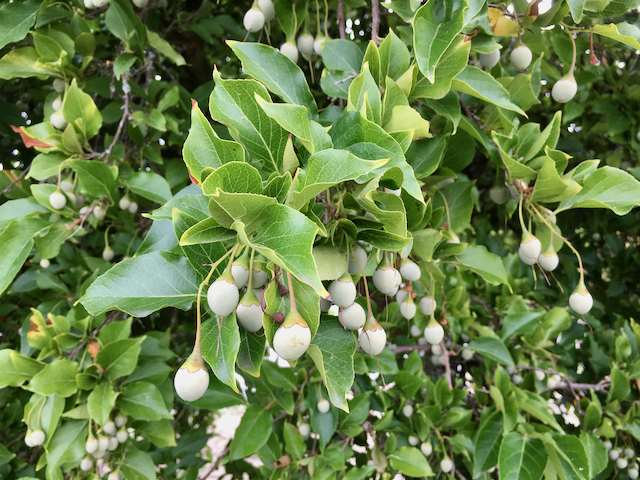
Styrax japonicus
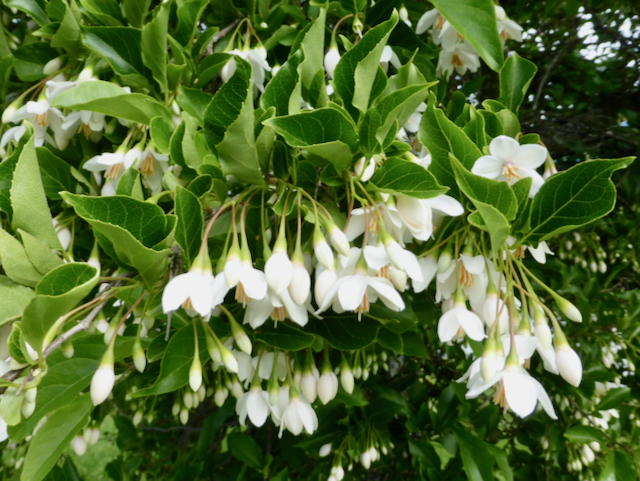
Styrax japonicus
Styrax japonicus (common snowbell, snowbell, styrax). The common snowbell is a variable species, widely distributed around China, Korea and Japan. In Vancouver, Japanese seedlings and selections tend to be compact trees with broad, low, layered, horizontal crowns, while those from Korea and China are invariably larger and more upright, but also with strongly horizontal, tiered branching. Regardless of geographic origin, all S. japonicus trees produce masses of sweetly fragrant, white, bell-shaped flowers in small clusters that festoon the undersides of the branches, typically after the leaves have emerged in June. The trees are thus best seen from below. Individual flowers are somewhat funnel-shaped, about 2 to 2.5 cm across, with five separate petals that flare slightly, exposing a compact cluster of straw-yellow anthers. Flowers are followed by hanging, silvery nut-like capsules in summer. Snowbell trees have slender branches that bear two alternating ranks of usually forward-pointing, dark green pointed leaves. In full sun, the leaves are smaller and often glossier, held upward and somewhat cupped, showing the lighter leaf undersides, while the trees are usually more compact than those grown with shade. In autumn, the leaves usually turn a soft butter yellow before falling.
Submitted by: Douglas Justice, Associate Director, Horticulture and Collections


